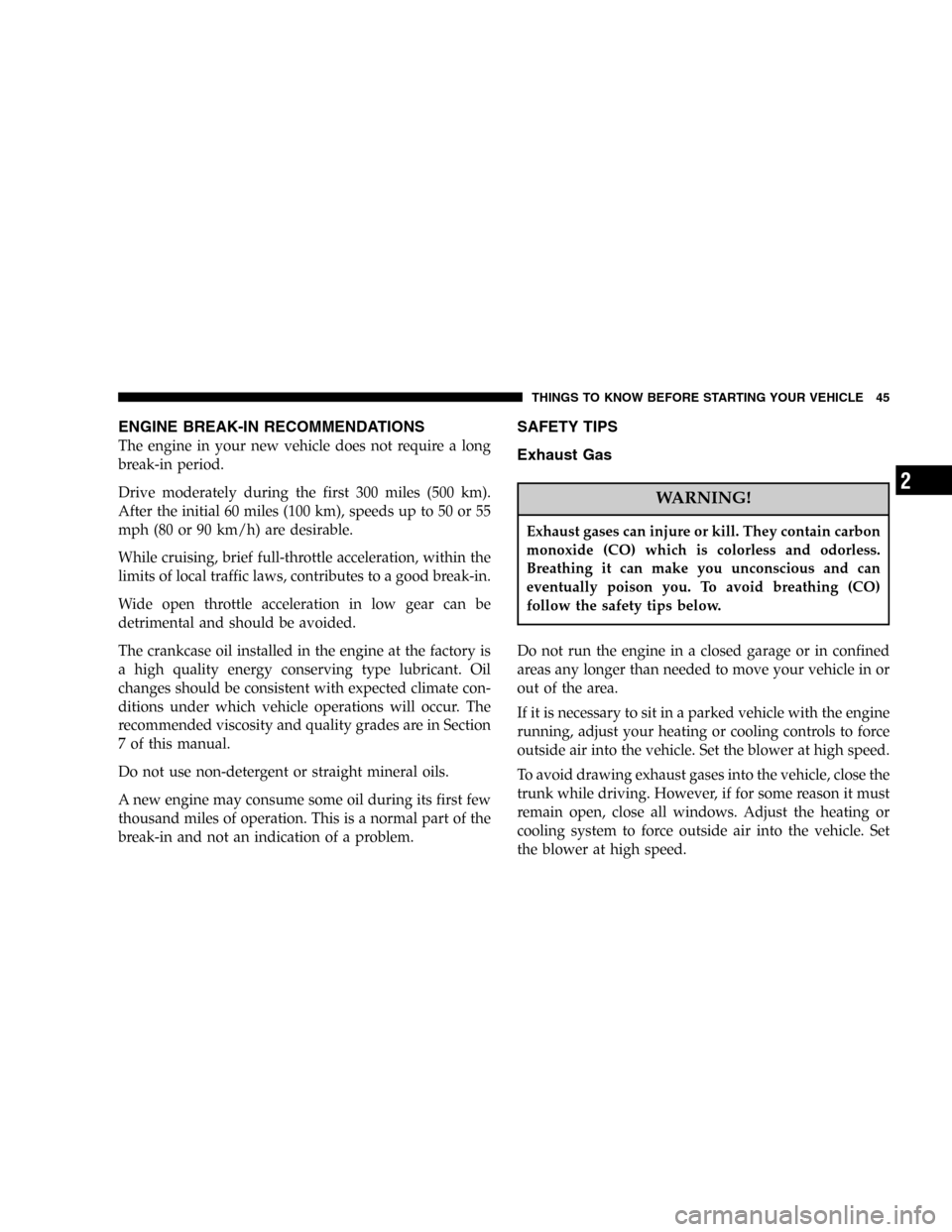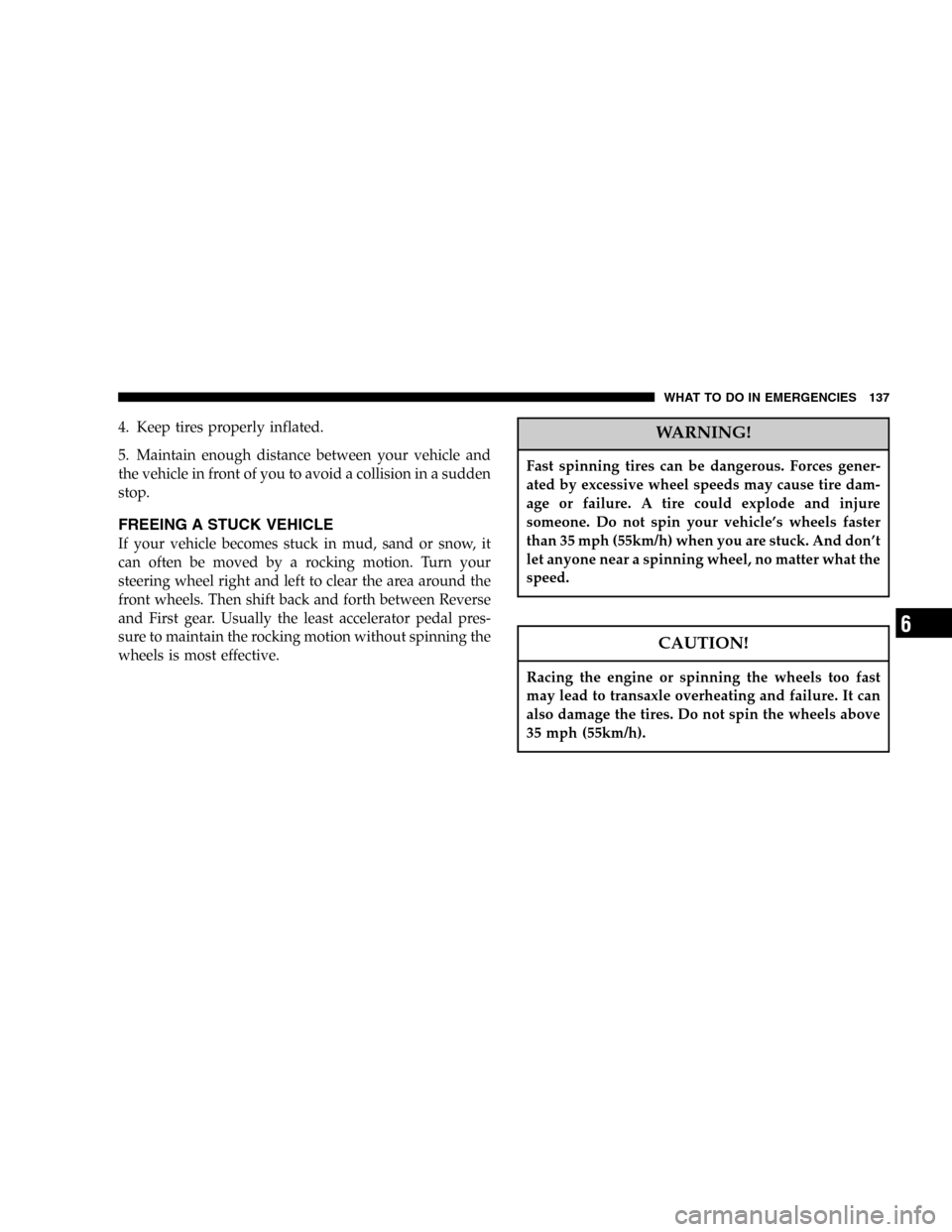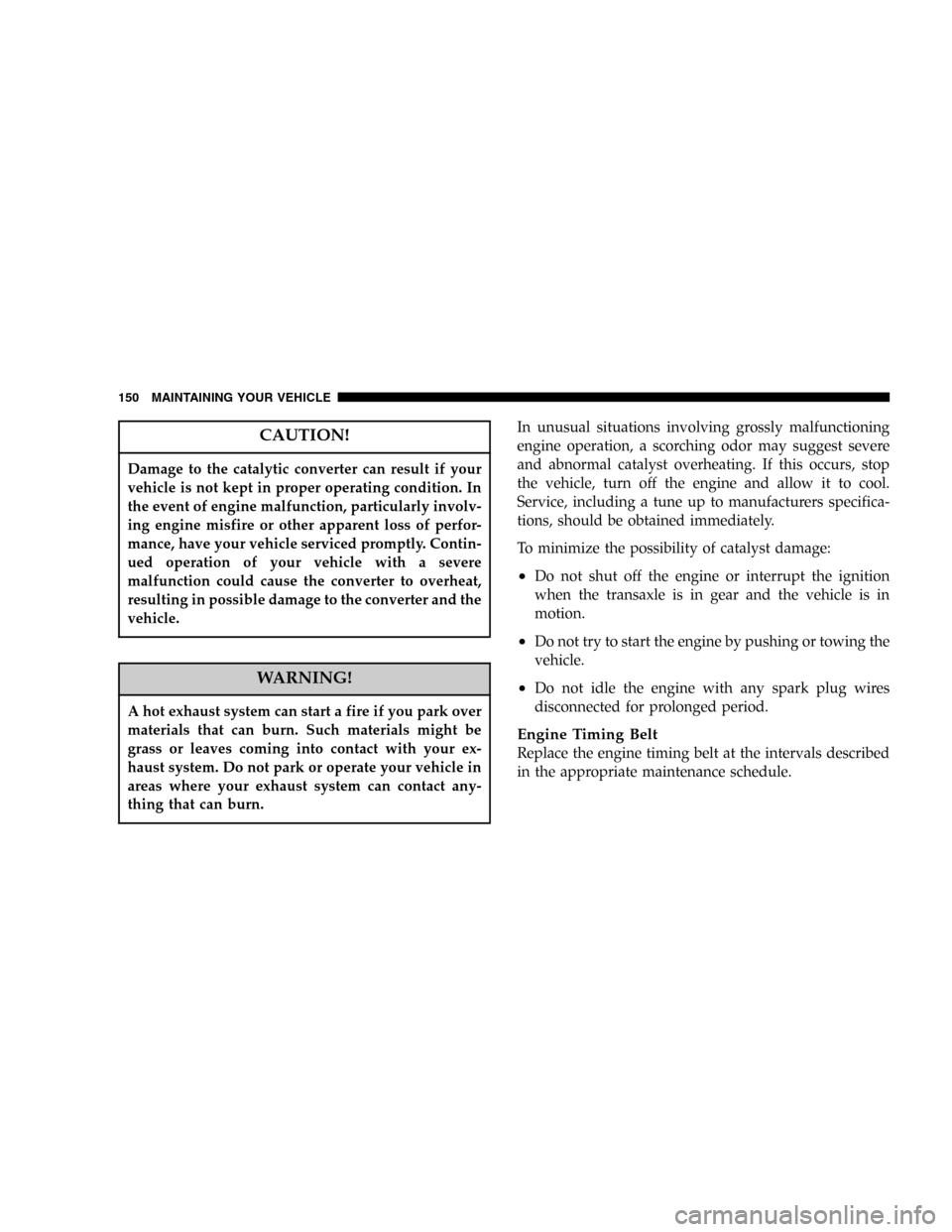heating DODGE NEON SRT 2005 2.G Owners Manual
[x] Cancel search | Manufacturer: DODGE, Model Year: 2005, Model line: NEON SRT, Model: DODGE NEON SRT 2005 2.GPages: 216, PDF Size: 7.18 MB
Page 45 of 216

ENGINE BREAK-IN RECOMMENDATIONS
The engine in your new vehicle does not require a long
break-in period.
Drive moderately during the first 300 miles (500 km).
After the initial 60 miles (100 km), speeds up to 50 or 55
mph (80 or 90 km/h) are desirable.
While cruising, brief full-throttle acceleration, within the
limits of local traffic laws, contributes to a good break-in.
Wide open throttle acceleration in low gear can be
detrimental and should be avoided.
The crankcase oil installed in the engine at the factory is
a high quality energy conserving type lubricant. Oil
changes should be consistent with expected climate con-
ditions under which vehicle operations will occur. The
recommended viscosity and quality grades are in Section
7 of this manual.
Do not use non-detergent or straight mineral oils.
A new engine may consume some oil during its first few
thousand miles of operation. This is a normal part of the
break-in and not an indication of a problem.
SAFETY TIPS
Exhaust Gas
WARNING!
Exhaust gases can injure or kill. They contain carbon
monoxide (CO) which is colorless and odorless.
Breathing it can make you unconscious and can
eventually poison you. To avoid breathing (CO)
follow the safety tips below.
Do not run the engine in a closed garage or in confined
areas any longer than needed to move your vehicle in or
out of the area.
If it is necessary to sit in a parked vehicle with the engine
running, adjust your heating or cooling controls to force
outside air into the vehicle. Set the blower at high speed.
To avoid drawing exhaust gases into the vehicle, close the
trunk while driving. However, if for some reason it must
remain open, close all windows. Adjust the heating or
cooling system to force outside air into the vehicle. Set
the blower at high speed.
THINGS TO KNOW BEFORE STARTING YOUR VEHICLE 45
2
Page 89 of 216

Window Fogging
Vehicle side windows tend to fog on the inside in mild
rainy or humid weather. To clear the windows, use the
A/C, PANEL and blower controls. Direct the panel
outlets toward the side windows. Do not use recirculate
without A/C for long periods as fogging may occur.
Interior fogging on the windshield can be quickly re-
moved by using the defrost position.
If the fogging problem persists, clean the inside window
surfaces. The cause of undue fogging may be dirt collect-
ing on the inside surface of the glass
NOTE:In cold weather, the use of the recirculate
position will cause windows to fog on the inside because
of moisture build up inside the vehicle. For maximum
defogging, use the Outside Air position.
Summer Operation
Air conditioned vehicles must be protected with a high-
quality antifreeze coolant to provide proper corrosion
protection and to raise the boiling point of the coolant for
protection against overheating. A 50% concentration is
recommended.
Outside Air Intake
When operating the system during the winter months,
make sure the air intake, directly in front of the wind-
shield, is free of ice, slush, snow or other obstructions
such as leaves. Leaves collected in the air-intake plenum
may reduce air flow and plug the plenum water drains.
The blower air will heat faster in cold weather if you use
only a low blower speed for the first few minutes of
vehicle operation.
Side Window Demisters
A side window demister outlet is at each end of the
instrument panel. These nonadjustable outlets direct air
toward the side windows when the system is in either the
FLOOR, MIX, or DEFROST mode. The air is directed at
the area of the windows through which you view the
outside mirrors.
UNDERSTANDING YOUR INSTRUMENT PANEL 89
4
Page 128 of 216

HAZARD WARNING FLASHER
The flasher switch is on top of the steering column,
just behind the steering wheel. Depress the switch
and both cluster indicators and all front and rear direc-
tional signals will flash. Depress the switch again to turn
Hazard Warning Flashers off.Do not use this emergency warning system when the
vehicle is in motion. Use it when your vehicle is disabled
and is creating a safety hazard for other motorists.
If it is necessary to leave the vehicle to go for service, the
flasher system will continue to operate with the ignition
key removed and the vehicle locked.
NOTE:With extended use, the flasher may wear down
your battery.
IF YOUR ENGINE OVERHEATS
In any of the following situations, you can reduce the
potential for overheating by taking the appropriate ac-
tion.
•On the highways—Slow down.
•In city traffic—While stopped, put transaxle in
neutral, but do not increase engine idle speed.
Hazard Flasher Switch
128 WHAT TO DO IN EMERGENCIES
Page 137 of 216

4. Keep tires properly inflated.
5. Maintain enough distance between your vehicle and
the vehicle in front of you to avoid a collision in a sudden
stop.
FREEING A STUCK VEHICLE
If your vehicle becomes stuck in mud, sand or snow, it
can often be moved by a rocking motion. Turn your
steering wheel right and left to clear the area around the
front wheels. Then shift back and forth between Reverse
and First gear. Usually the least accelerator pedal pres-
sure to maintain the rocking motion without spinning the
wheels is most effective.
WARNING!
Fast spinning tires can be dangerous. Forces gener-
ated by excessive wheel speeds may cause tire dam-
age or failure. A tire could explode and injure
someone. Do not spin your vehicle’s wheels faster
than 35 mph (55km/h) when you are stuck. And don’t
let anyone near a spinning wheel, no matter what the
speed.
CAUTION!
Racing the engine or spinning the wheels too fast
may lead to transaxle overheating and failure. It can
also damage the tires. Do not spin the wheels above
35 mph (55km/h).
WHAT TO DO IN EMERGENCIES 137
6
Page 150 of 216

CAUTION!
Damage to the catalytic converter can result if your
vehicle is not kept in proper operating condition. In
the event of engine malfunction, particularly involv-
ing engine misfire or other apparent loss of perfor-
mance, have your vehicle serviced promptly. Contin-
ued operation of your vehicle with a severe
malfunction could cause the converter to overheat,
resulting in possible damage to the converter and the
vehicle.
WARNING!
A hot exhaust system can start a fire if you park over
materials that can burn. Such materials might be
grass or leaves coming into contact with your ex-
haust system. Do not park or operate your vehicle in
areas where your exhaust system can contact any-
thing that can burn.
In unusual situations involving grossly malfunctioning
engine operation, a scorching odor may suggest severe
and abnormal catalyst overheating. If this occurs, stop
the vehicle, turn off the engine and allow it to cool.
Service, including a tune up to manufacturers specifica-
tions, should be obtained immediately.
To minimize the possibility of catalyst damage:
•Do not shut off the engine or interrupt the ignition
when the transaxle is in gear and the vehicle is in
motion.
•Do not try to start the engine by pushing or towing the
vehicle.
•Do not idle the engine with any spark plug wires
disconnected for prolonged period.
Engine Timing Belt
Replace the engine timing belt at the intervals described
in the appropriate maintenance schedule.
150 MAINTAINING YOUR VEHICLE
Page 206 of 216

Cup Holder............................ 62
Customer Assistance.................... 196
Daytime Running Lights.................. 57
Dealer Service......................... 144
Defroster, Rear Window................... 90
Defroster, Windshield..................46,86
Deploying, Airbag....................... 35
Diagnostic System, Onboard............... 142
Dimmer Control........................ 55
Dimmer Switch, Headlight................. 57
Disarming, Theft System.................. 22
Disposal
Engine Oil.......................... 148
Door Locks............................ 13
Door Locks, Automatic................... 15
Downshifting.......................... 100
Drive Belts............................ 149
Driving
On Slippery Surfaces.................. 136
Electric Remote Mirrors................... 50Emergency, In Case of
Jacking............................. 130
Jump Starting........................ 133
Towing............................. 138
Emergency Trunk Release................. 17
Emission Control System Maintenance....... 180
Engine............................... 141
Break-In Recommendations............... 45
Checking Oil Level.................... 145
Compartment........................ 141
Cooling............................ 157
Exhaust Gas Caution.................. 123
Jump Starting........................ 133
Oil ..........................145,176,177
Oil Change Interval................... 146
Oil Filler Cap........................ 148
Oil Filter............................ 177
Oil Selection......................... 147
Oil Synthetic......................... 148
Overheating......................... 128
Temperature Gauge.................... 73
Timing Belt.......................... 150
Exhaust Gas Caution..................45,123
206 INDEX
Page 210 of 216

Manual, Service........................ 200
Manual Transaxle..................95,98,164
Fluid Level Check..................... 164
Frequency of Fluid Change.............. 164
Lubricant Selection.................... 164
Map/Reading Lights..................... 54
Master Cylinder........................ 163
Mirrors............................... 49
Electric Remote....................... 50
Outside............................. 49
Rearview............................ 49
Modifications/Alterations, Vehicle............ 6
Mopar Parts........................144,200
Multi-Function Control Lever.............56,57
Occupant Restraints...................... 23
Odometer
Trip ................................ 72
Oil, Engine.........................145,176
Capacity............................ 176
Change Interval...................... 146
Checking........................... 145
Disposal............................ 148Filter.............................. 149
Identification Logo.................... 148
Materials Added to.................... 148
Quality............................. 148
Recommendation..................147,176
Synthetic........................... 148
Viscosity............................ 148
Oil Pressure Light....................... 70
Onboard Diagnostic System............142,143
Operator Manuals (Owner’s Manuals)......... 4
Outside Air Intake....................... 89
Overheating, Engine..................... 128
Owner’s Manual......................4,200
Paint Care............................ 165
Panic Alarm........................... 19
Parking Brake......................... 100
Passing Light........................... 57
Pets.................................. 44
Placard, Tire and Loading Information....... 108
Power
Door Locks.......................... 14
Steering.........................103,154
210 INDEX